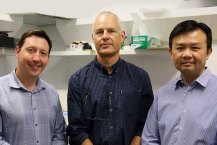Artificial intelligence could be used to review – and possibly one day even make – cancer diagnoses if a team of WA researchers, led by PathWest anatomical pathologist Jeremy Parry, is successful in training a specialised computer to detect abnormalities in lymph nodes.
The bold new project, which featured on Channel 7 News (external site) is one of 10 local research projects awarded funding in the latest round of the Department of Health-funded Research Translation Projects (RTP).
Dr Parry and his co-researchers will take a computer capable of "deep learning" and teach it to detect changes in lymph nodes that may or may not be malignant. With later refinements, the computer could potentially discern malignant from benign changes.
The research team, which includes experts in artificial intelligence from Murdoch University's College of Science, Health, Engineering and Education will "teach" the computer using digitised whole-slide scans of lymph node tissue collected from Western Australian patient samples.
Dr Parry hopes that through the process of deep learning – in which the computer learns to recognise patterns within data it has already analysed – the computer might eventually be able to detect nuanced early indicators of cancer.
Dr Parry's says the aim of his project is not to replace pathologists in analysing samples, but to assist in the review and validation of their findings.
In a second part of the project, Dr Parry and his team will assess the value of using digitised whole-slide scans of tissue samples across the WA health system.
The present system for examining tissue samples involves putting them on glass slides so that they can be viewed under a microscope.
"If we need a second opinion we must physically transport the slide to wherever the person is, which could be at another hospital – or even in another state," Dr Parry explained.
"However if we take the sample on the slide and then scan it using our digital whole-slide pathology scanner, we have access to an image that we can send anywhere in the world and which can be viewed instantaneously."







